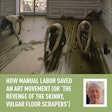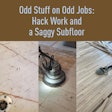So I don't often work with subcontractors, however I have a new project in a town 50 miles away with a deadline to complete it in 33 calendar days. With my regular crews having to drive 75–90 minutes each way to get this one done, it made sense to use the local help, as well.
I call on a sub I know, Pauley (not his real name). With my supervision, he CAN up his game and work to my standards, procedures, and approach to work. On his own, he CHOOSES to not do some things he should be doing to make his work, procedures and attitude top-notch.
He has been on the job a few days now, removing the old engineered wood floor and something that came up on the second day: the ceramic tile which was under about half of the house (that explained why the original floor sloped awkwardly in several areas). When the tile was exposed, Pauley contacted me right away and reacted like the job deadline was blown and “this job will never get done on time!” This is typical of Pauley when any situation changes on him. A hailstorm of fireballs rains down from above and all is lost.
If you are the flooring installer or contractor for a project, you (should) have a written agreement detailing who, what, when, where and how the project will unfold. ANY deviation from that is a profit center.
This is one of many aspects of Pauley’s modus operandi that can be better and, indeed, profitable. Consider this: If you are the flooring installer or contractor for a project, you (should) have a written agreement detailing who, what, when, where and how the project will unfold. ANY deviation from that is a profit center. With the right approach, you can really benefit because, instead of complaining about the situation that developed, you are the problem-solver for the client and that, my friends, is worth money!
I text (not even call!) the GC, explain the hidden condition, propose the solution, and in a few moments he gives me the OK with a healthy change order AND a four-day extension of the deadline, to go ahead and demo the tile and thinset. Problem solved—money in the bank.
This is not a special or lucky case. This happens in our industry all the time; after all, nothing is straightforward in our line of work.
Even basic sanding jobs present these opportunities. Just two days ago I was able to add $405 to a $1,700 natural two-coat job just because the owner wanted … get ready for it … 10 boards (1½”x 28-1/4”) put into a niche that a built in bookcase used to live in and two crossing 2” boards at two openings where the original floor did not reach the new open doorways.
I cut the 10 boards to length at my shop plus a few boards with 3/8” variations on the final width for the next day. The sanding boys dropped them into the space—no saws needed. The Festool/Fein Tool work for the two feature strips wasn’t even 45 minutes of work. That added 24 percent to the job.
How to handle surprise situations or simple client requests, with the right approach or presentation, will have the client glad to give you more money for having their best interest in mind and for being their problem-solver. Be successful in this business. Get the right tools—this includes relationship tools and negotiating tools.
On my next post, I will continue my story with Pauley, about our next phase, the floor prep.

































